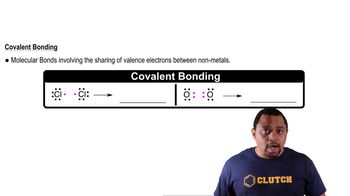Trifluoroacetic acid has the chemical formula CF3CO2H. It is a colorless liquid that has a density of 1.489 g/mL (a) Trifluoroacetic acid contains one CF3 unit and is connected to the other C atom which bonds with both O’s. Draw the Lewis structure for trifluoroacetic acid.
Ammonia reacts with boron trifluoride to form a stable compound, as we saw in Section 8.7. (a) Draw the Lewis structure of the ammonia–boron trifluoride reaction product.
 Verified step by step guidance
Verified step by step guidance
Verified video answer for a similar problem:
Key Concepts
Lewis Structures

Covalent Bonding

Molecular Geometry

Trifluoroacetic acid has the chemical formula CF3CO2H. It is a colorless liquid that has a density of 1.489 g/mL. (b) Trifluoroacetic acid can react with NaOH in aqueous solution to produce the trifluoroacetate ion, CF3COO2. Write the balanced chemical equation for this reaction.
Trifluoroacetic acid has the chemical formula CF3CO2H. It is a colorless liquid that has a density of 1.489 g/mL. (d) How many milliliters of a 0.500 M solution of NaOH would it take to neutralize 10.5 mL of trifluoroacetic acid?
Ammonium chloride, NH4Cl, is a very soluble salt in water. (c) If you dissolve 14 g of ammonium chloride in 500.0 mL of water, what is the molar concentration of the solution?
Ammonium chloride, NH4Cl, is a very soluble salt in water. (d) How many grams of silver nitrate do you need to add to the solution in part (c) to precipitate all of the chloride as silver chloride?
